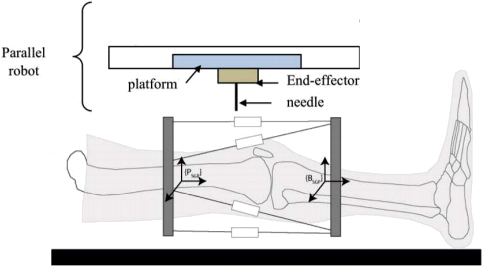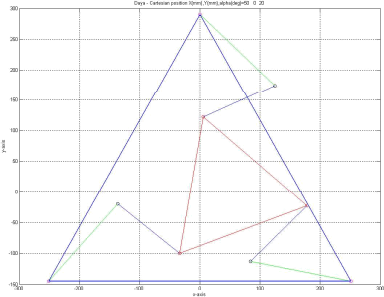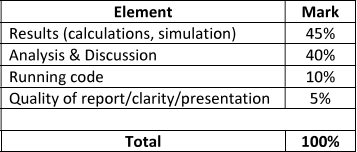UFMF4X-15-M Robotic Fundamentals
Hello, dear friend, you can consult us at any time if you have any questions, add WeChat: daixieit
UFMF4X- 15-M Robotic Fundamentals
Coursework: Serial and Parallel Robot Kinematics
This document explains requirements for the assessed coursework for the UFMF4X-15-M Robotic Fundamentals module.
The module is assessed in one report that is worth 50% of your overall mark. The assessment will be based on a series of simulated experiments using a series and a parallel manipulator.
The coursework also includes suggestions of topics you may want to work on in order to demonstrate a fuller understanding of the more advanced parts and attain a higher mark. This additional work is expressed here in an open-ended way, as appropriate for Masters level study.
The deadline for submission is 11th of January 2024,Thursday, 2pm on UWE Blackboard.
PART I:
A. From material covered during lectures, lab exercises and examples, complete the following tasks:
1) Derive a DH representation of forward kinematics for the Lynxmotion arm1. Use MATLAB, lecture material and further reading. Include all your investigations and report this.
2) Analyse the workspace of the centre of the wrist (5th joint) when each preceding joint moves through its range of motion and plot the 2D and 3D views of the workspace.
3) Derive the inverse kinematics model for the manipulator (analytical solution).
B. Complete the following:
1) Plan a task* in MATLAB with at least 5 positions. This process should give you at least 5 sets of Cartesian coordinates specifying the end-effector position and orientation in 3D space.
2) Solve the Inverse Kinematics for these positions in 3D space and obtain sets of Joint Coordinates. Create an appropriate plot/animation in MATLAB for the motion of the robot.
3) Implement 3 different trajectories between the Cartesian Points identified above and create an appropriate plot to demonstrate them):
a. Implement a free motion between the points
b. Implement a straight line trajectory between the points
c. Set an obstacle between any two points (e.g. a cylinder between point 3 and 4) and implement an object avoidance trajectory.
PART II:
Consider a planar parallel robot used in a surgical procedure to position a needle above the patient, see Figure 1 .

Figure 1 . Needle positioning parallel Robot.
The parallel robot consists of a f xed Base plate, a Moving platfor m ,sx passive revolute joints (Mi and ppi where i=1:3) and three active revolute joints (PBi where i=1:3) ![]() The ith strut of the robot consists therefore of three joints that are subdivided in the upper section SA
The ith strut of the robot consists therefore of three joints that are subdivided in the upper section SA![]() and the lower section L. For further information to the robot see its kinematic model in Figure 2 .
and the lower section L. For further information to the robot see its kinematic model in Figure 2 .
Develop a kinematic simulation of the parallel robot in MATLAB to
1) solve and implement parallel robot Inverse kinematics. calculate the joint coordinates 6i where i=1:3 from the cartesian parameters of the platform ' s centre {c} (where the needle is based) . These parameters are the (x![]()
![]() Y)coordinates and the orientation of the platform (a) . plot the kinematic model in two different positions. changing the cartesian input parameters should adapt each leg to the new cartesian position. An example plot is show in Figure 3 .
Y)coordinates and the orientation of the platform (a) . plot the kinematic model in two different positions. changing the cartesian input parameters should adapt each leg to the new cartesian position. An example plot is show in Figure 3 .
2) plot the parallel robots workspace for a given orientation a. This is crucial for the mechanism synthesis analysis.

Figure 2: PIanar parallel Robot kinematic ModeI

Figure 3:smulated robot motion
PART II:
TO ATTAIN A HIGHER MARK CARRY OUT THE FOLLOWING:
choose a relevant topic that is not mentioned here, but relevant to the coursework subject domain, and carry ut theoretical or experimental work on that topic. For example, this work could be analysing alternative methods of inverse kinematics calculation such as motor babbling, optimisation, screw theory, etc. , investigating methods and algorithms that can be used to avoid problems when operating close to a singularity in the robot's workspace etc. or something else. Discuss your chosen topic with the module tutors before you start.
Reporting Details
You have to write a report, using not more than 3000 words to describe y![]() ur investigations and results.
ur investigations and results.
You need to:
1) Demonstrate that you understand the theory behind the approaches y![]() u use to sove a problem.
u use to sove a problem.
2) critical assessment and analysis of the relative merits of the approaches y![]() u have used
u have used
3) show that you have appreciation of issues and principles used to establish safe operation of
manipulators in the human environment
4) present y![]() ur conclusions.
ur conclusions.
5) provide any references using the Harvard system2
6) provide any code you have written in an appendix AND the actual . m files (Matlab) as attachments.
Assessment weighting:
The following table is given for clarity of the marking process per question.

However, for each of the uestion you should keep in mind that your report will be marked based on analysis of your results, sufficient evidence and references that support your claims and clarity and relevance of your discussion , as shown below:

2024-01-09
Serial and Parallel Robot Kinematics